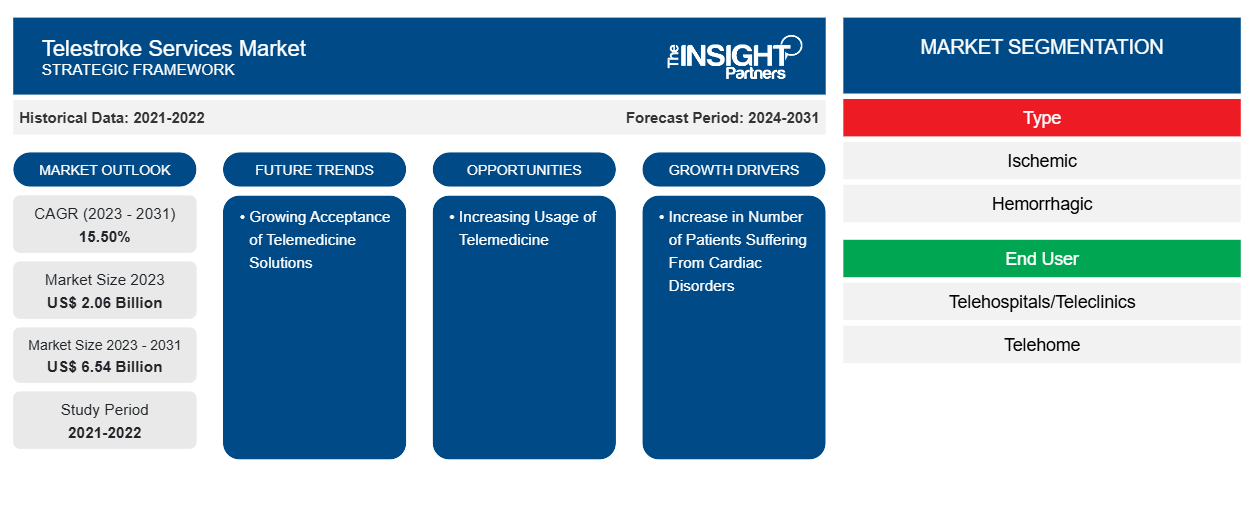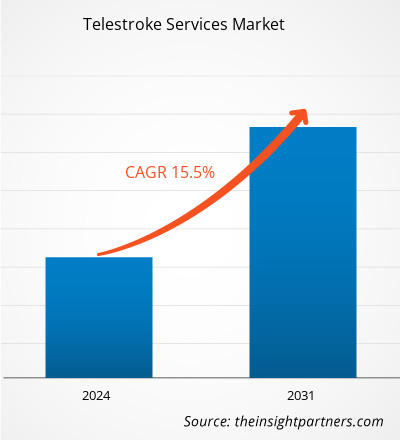The telestroke services market size is projected to reach US$ 6.54 billion by 2031 from US$ 2.06 billion in 2023. The market is expected to register a CAGR of 15.50% during 2023–2031. The emergence of technologically advanced products will likely remain a key trend in the market.
Telestroke Services Market Analysis
The market is expanding as a result of both the number of cardiovascular patients leaving and the rising global incidence of stroke cases. The market is expected to grow due to the growing incidence of cardiovascular diseases and strokes and the growing use of telemedicine, cutting-edge technology, and telestroke services. Supportive reimbursement policies and a high telemedicine and telestroke services adoption rate are expected to propel the telestroke services market. The Asia Pacific region is anticipated to overgrow due to increased product launches, improved healthcare infrastructure, and technological advancements.
Telestroke Services Market Overview
One of the leading causes of death and disability in the world is stroke. Stroke was the second most common cause of death, as per the World Health Organization (WHO) in 2016. Stroke is a significant public health concern that harms society and the economy. In the upcoming decades, the burden of stroke on public health will rise as a result of shifting demographics, especially in developing nations. Thus, the rising number of stroke cases will increase the acceptance of telemedicine solutions, thereby driving the market's growth.
Customize This Report To Suit Your Requirement
You will get customization on any report - free of charge - including parts of this report, or country-level analysis, Excel Data pack, as well as avail great offers and discounts for start-ups & universities
Telestroke Services Market: Strategic Insights

-
Get Top Key Market Trends of this report.This FREE sample will include data analysis, ranging from market trends to estimates and forecasts.
Telestroke Services Market Drivers and Opportunities
An increase in the Number of Patients Suffering from Cardiac Disorders Favors the Market Growth
Globally, cardiovascular diseases (CVDs) rank among the top causes of death. The World Health Organization estimates that 17.9 million deaths worldwide in 2019 were related to CVDs or 32% of all deaths. Moreover, heart attacks and strokes were the cause of 85% of these fatalities. Low- and middle-income nations account for at least 75% of cardiovascular disease-related deaths worldwide.
Furthermore, compared to the general population, cardiac patients have a markedly increased risk of heart disease and stroke. The most significant predisposing risk factor for acute ischemic stroke (AIS) is thought to be CVD. In patients with coronary artery disease, the occurrence of AIS doubles, and in patients with atrial fibrillation, it multiplies fivefold. Furthermore, stroke patients are particularly susceptible to severe cardiac adverse events because brain damage can change the autonomic and neurohormonal pathways that regulate heart function. Specifically, cerebral autoregulation may be compromised by AIS, resulting in cerebral blood flow being reliant on heart function. Physicians specializing in cardiology and stroke work closely with industry partners to develop tools, resources, and treatments that can help reduce treatment times and improve efficiency. The market is growing due to the augmented demand and uptake of telestroke services brought on by the increased frequency of these CVD cases.
Increasing Usage of Telemedicine
Medical services handle illnesses and complicated clinical issues efficiently and promptly. However, as the population gets older and the prevalence of chronic illnesses rises, there is an increasing need for medical services, driving up costs and placing pressure on the healthcare systems. For over thirty years, telemedicine has been utilized by healthcare professionals to treat stroke victims. The technology started as an audio-visual platform, allowing neurologists to observe a patient exhibiting stroke symptoms. Telestroke services, which use connected healthcare channels to increase the diagnosis and treatment of stroke victims, are helping healthcare systems worldwide save lives. The Furthering Access to Stroke Telemedicine (FAST) Act was a part of the Creating High-Quality Results and Outcomes Needed to Improve Chronic (CHRONIC) Care Act of 2017. With the lifting of rural restrictions and the expansion of hospital health insurance to cover telestroke services starting in 2021, this act may enable more stroke patients to receive telehealth services. Thus, the telestroke services market is anticipated to present opportunities in the upcoming years due to the factors above.
Telestroke Services Market Report Segmentation Analysis
Key segments that contributed to the derivation of the telestroke services market analysis are type, and end user.
- Based on type, the telestroke services market is divided into ischemic and hemorrhagic. The ischemic segment held the most significant market share in 2023.
- By end user, the market is segmented into telehospitals/teleclinics, telehome, and others. The telehospitals/teleclinics segment held the largest share of the market in 2023.
Telestroke Services Market Share Analysis by Geography
The geographic scope of the telestroke services market report is mainly divided into five regions: North America, Asia Pacific, Europe, Middle East & Africa, and South & Central America.
Due to the presence of major market players, the growth of the healthcare and research sectors in the region, and other factors, it is projected that the telestroke services market in the region will experience significant growth over the forecast period. In addition, the region's increasing telemedicine awareness, better healthcare facilities, and suitable reimbursement guidelines are driving up demand for telestroke services in North America. The Asia-Pacific region will have abundant growth opportunities throughout the forecast period because of rising investments, technological advances, and an increase in new product launches.
Telestroke Services Market Regional Insights
The regional trends and factors influencing the Telestroke Services Market throughout the forecast period have been thoroughly explained by the analysts at The Insight Partners. This section also discusses Telestroke Services Market segments and geography across North America, Europe, Asia Pacific, Middle East and Africa, and South and Central America.
Telestroke Services Market Report Scope
| Report Attribute | Details |
|---|---|
| Market size in 2023 | US$ 2.06 Billion |
| Market Size by 2031 | US$ 6.54 Billion |
| Global CAGR (2023 - 2031) | 15.50% |
| Historical Data | 2021-2022 |
| Forecast period | 2024-2031 |
| Segments Covered |
By Type
|
| Regions and Countries Covered |
North America
|
| Market leaders and key company profiles |
|
Telestroke Services Market Players Density: Understanding Its Impact on Business Dynamics
The Telestroke Services Market is growing rapidly, driven by increasing end-user demand due to factors such as evolving consumer preferences, technological advancements, and greater awareness of the product's benefits. As demand rises, businesses are expanding their offerings, innovating to meet consumer needs, and capitalizing on emerging trends, which further fuels market growth.

- Get the Telestroke Services Market top key players overview
Telestroke Services Market News and Recent Developments
The telestroke services market is evaluated by gathering qualitative and quantitative data post primary and secondary research, which includes important corporate publications, association data, and databases. A few of the developments in the telestroke services market are listed below:
- UPMC has expanded stroke specialty care services at UPMC Cole by offering 24/7, 365 virtual consultation services with world-renowned stroke specialists from UPMC Stroke Institute at UPMC Presbyterian, a certified Comprehensive Stroke Center. (Source: UPMC, Press Release, Janury 2024)
- Lakewood Ranch Medical Center received the American Heart Association/ American Stroke Association's "Get With The Guidelines-Stroke Gold Plus Quality Achievement" award. The award recognizes the hospital's commitment to ensuring stroke patients receives the most appropriate treatment according to nationally recognized, research-based guidelines based on the latest scientific evidence. (Source: Lakewood Ranch Medical Center, Press Release, August 2020)
Telestroke Services Market Report Coverage and Deliverables
The “Telestroke Services Market Size and Forecast (2021–2031)” report provides a detailed analysis of the market covering below areas:
- Telestroke services market size and forecast at global, regional, and country levels for all the key market segments covered under the scope
- Telestroke services market trends as well as market dynamics such as drivers, restraints, and key opportunities
- Detailed PEST/Porter’s Five Forces and SWOT analysis
- Telestroke services market analysis covering key market trends, global and regional framework, major players, regulations, and recent market developments.
- Industry landscape and competition analysis covering market concentration, heat map analysis, prominent players, and recent developments for the telestroke services market
- Detailed company profiles
Frequently Asked Questions
Which region dominated the telestroke services market in 2023?
What are the driving factors impacting the telestroke services market?
What are the future trends of the telestroke services market?
Which are the leading players operating in the telestroke services market?
What is the expected CAGR of the telestroke services market?
- Historical Analysis (2 Years), Base Year, Forecast (7 Years) with CAGR
- PEST and SWOT Analysis
- Market Size Value / Volume - Global, Regional, Country
- Industry and Competitive Landscape
- Excel Dataset
Recent Reports
Testimonials
Reason to Buy
- Informed Decision-Making
- Understanding Market Dynamics
- Competitive Analysis
- Identifying Emerging Markets
- Customer Insights
- Market Forecasts
- Risk Mitigation
- Boosting Operational Efficiency
- Strategic Planning
- Investment Justification
- Tracking Industry Innovations
- Aligning with Regulatory Trends





















 Get Free Sample For
Get Free Sample For